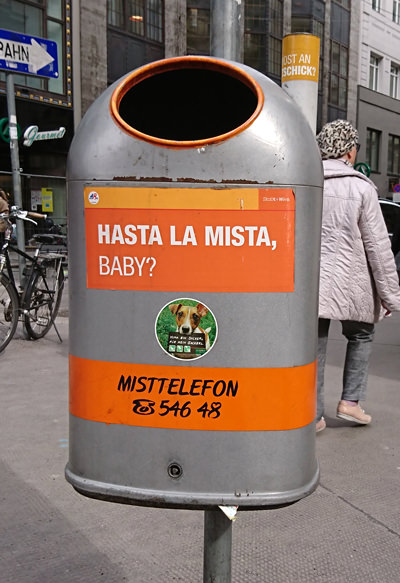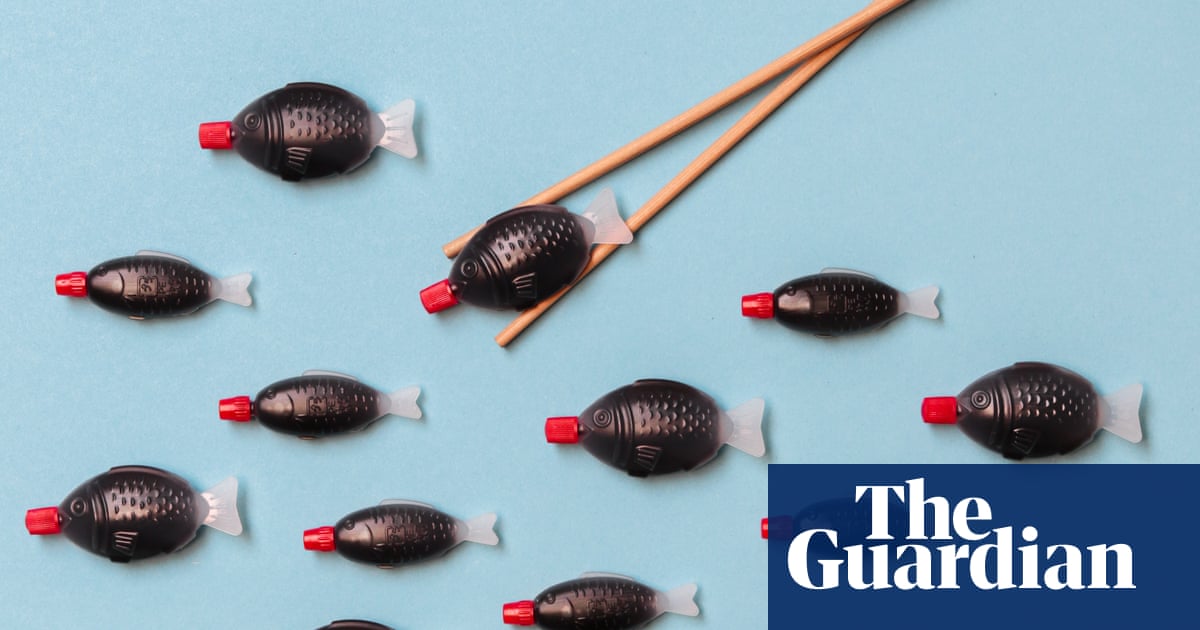The device known as shoyu-tai (or soy-sauce snapper in Japanese) was invented in 1954 by Teruo Watanabe, the founder of Osaka-based company Asahi Sogyo, according to a report from Japan’s Radio Kansai.
It was then common for glass and ceramic containers to be used but the advent of cheap industrial plastics allowed the creation of a small polyethylene container in the shape of a fish, officially named the “Lunch Charm”.
The invention quickly spread around Japan and eventually worldwide, and it is estimated that billions have been produced.
I’m gonna say it:
The problem is not the fish-shaped plastic per se, but the fact that so much of it ends up in the ocean: Why do we still not collect and burn plastics properly? People throw their waste everywhere because there’s not enough waste bins in comfortable walking distance. In Vienna, where waste bins are frequent on the streets (you basically never have to walk more than 30 meters to one, no matter where you sit and pause, somehow), there is literally no litter in the environment. No plastic articles or metal cans on the streets. Very rare cigarettes laying around. That’s because Vienna has enough trash cans. Many cities don’t have that and people have literally no choice to dispose of their trash properly because there’s simply no trash cans around, so you either carry your dirty plastic packaging in your backpack and therefore sully your backpack with the grease on the packaging, or throw it into the environment.
Then, there needs to be strict laws that say that all plastic waste has to be burned, not dumped into the environment.
Then, biodegradable bioplastics would also mitigate this problem a lot.
I don’t think you even begin to understand what it’s like to have billions of people on the earth.
No matter what we do, people will still slip through the cracks and this litter will get out.
People throw their waste everywhere because there’s not enough waste bins in comfortable walking distance
I see almost daily people throwing trash on the street in front of an empty recycle bin. I think the issue is more about people not giving a shit than convenience of finding a trashcan or keeping stuff in your pocket until you do.
I think the issue is more about people not giving a shit
but do these trash cans have funny jokes on them like these ones:



“mist” is trash in german
Eh. No jokes, no. The most engaging thing I remember seeing around in the city was a “vote” panel for cigarette butts with silly questions; but even that has gone away.
It is unfortunate that we’re at this point. Hopefully other places do fare better.
In addition, too many people don’t even care enough to use the correct bin. Every bin day my neighbours bins are overflowing with no recyclables in their recycling bin. I wouldn’t be surprised if the bins were meaningless and it all went in a hole in the ground
it practically does all go to the same incineration site. the recycle bins are mostly to make you believe otherwise, for political reasons, sothat you look at plastic in general more favorable. but practically none of it gets recycled.
That was true a long time ago. And remains true in some places, but since we started pushing the different bins, things progressed on that front. Plenty of place have actual recycling facilities (although their efficiency is another topic). Of course, in some far away area, it is not practical to sort stuff, but it’s kind of a chicken and egg problem. Infrastructure see no point in making large facilities for processing recyclable if they’re not sorted, and people see no point in sorting their trash if the infrastructure isn’t available. Putting colored recycling bins everywhere to initiate the process was cheaper.
Ironically, Japan has almost no trash bins. You’ll find them next to vending machines - you’re expected to consume there and throw away packaging immediately, or take the rubbish with you.
So pick a lane. 100 bins per square kilometer, or none.
Anywhere in between evidently sucks.
Burning plastic does not mitigate its environmental effects, and infact would increase air pollution and microplastics exponentially if we were to start.
I fully agree with the rest, but burning plastic is definitely not the answer.
i too would like any kind of reasonable source about this, because i’ve heard very different from a many colleagues who work in this field.
modern incineration sites are very clean and produce no significant air polluting output. at least in modern sites. microplastics is also not an issue with these. the problem is that the trash gets thrown in rivers and forests where it breaks into microplastics, but that isn’t an issue if it’s all collected and incinerated.
So, did you just come up with that, or do you actually know something about industrial incinerators used for power generation?
Date rapists in shambles
For context, these containers are really popular for storing drugs like GHB
I’m not defending the use but should mention that these are convenient over traditional sauce packets. They allow precise application in a droplet form, don’t spill everywhere, and can be closed with the included cap.
But offer no benefit over a simple serving bottle.
Correct. These are often found in takeaway containers.
I’ve never seen these things before but it does seem like a waste of plastic. Even sachets of sauce shouldn’t be handed out in most circumstances, at least for dine-in food in fast food places - use dispensers and paper cups. I wonder if there is a biodegradable sachet material which has a couple of years shelf life but degrades thereafter.
The “fish-shaped” is rather irrelevant. The point is that it is a single -use plastic thing. With very little content in relation to the plastic used.
I thought it would have been very relevant.
It looks like a fish lure.
If this is floating around at sea I don’t see why other fish (and maybe certain sea birds?) wouldn’t think it’s prey, and it even has a bright red indicator that makes it easy to spot.
Only relevant for countries that still “recycle” plastics by throwing them into the sea.
So all of them.
All of them participate, yes, but on vastly different levels. There are countries that actually collect and recycle.
There are countries that actually collect and recycle.
And we do that in Australia, we just don’t have the capacity to process all the waste (Between 85%-90% of plastic waste goes to landfill instead), and even then the recyclability of plastic is vastly overstated.
It’s a much better idea to just prevent the plastic waste being produced in the first place.
You misunderstand. I’m saying those countries that think they’re doing a good job, their shit’s going straight to the water too. They’re all fooling themselves. Or more accurately they’re fooling you the consumer and thosr believing recycling works. It doesn’t for the vast vast majority of plastics. So all of them are dumping Plastics in the water.
Some thrash will end up in nature no matter what you do, especially small and light items. That’s why it’s good practice to design packaging do that it does minimal harm if it ends up in nature.
I was thinking about these literally just yesterday. I’m wondering if they could be essentially replaced with something like those wax bottle candies. Maybe not the best for places that reach extreme temperatures but some places could do it without issue.
Wonder if you could put soy sauce in wax like those wax bottle candies instead
If it exists, I can’t wait to hand these out during Halloween
I’ve got a fridge drawer for these.
Al Gore is going to have a field day with this.
Scrolling by I literally thought “Man, that candy looks delicious, what’s this article about?” And then read the headline… 🫠
Some people just don’t appreciate the irony of killing turtles with fish-shaped plastic, what can you do
You know what’s killing more turtles? Irresponsible mega-corporations.
Nothing is ever produced by them that isn’t bought by someone who should have said no.
If companies are to blame then that’s the media companies who don’t inform the consumers about their responsibilities but instead sell ads for harmful products.
If corporations would not give people the choice of buying one way plastic containers, then no one would buy them.
Good luck relying on informed customers when customers are too busy living their lives to keep track of a billion different reasons for why they shouldn’t buy one product over another. Also, these are given out at restaurants. Do you recommend refusing to go to a restaurant if they happen to see this dispenser being included there?
How is making sure millions of people are informed and making the “correct” decision every time a better solution than simply restricting on the supply side?
It’s the only way to make a change. Businesses can buy politicians to avoid regulations.
It’d cost more to buy out the politicians than to switch to the sachets that are still allowed. The sachets are cheaper to produce since they use less plastic and businesses would be happy to be “forced” to switch to a cheaper alternative along with all their competitors.
In this case. Most of the times the politician is cheaper.
No, you can’t blame consumers for corporations bad behavior, consumers act in their own self interest, not a collective self interest. This is precisely why we have regulations.
I blame the humans who keep being consumers.
A Spanish company (I imagine there are a few worldwide) develops compostable bioplastic containers using PLA, polylactic acid, the most used plastic in 3D printing, in food safe formulations. I suppose there are limitations on what it can contain, and I don’t know if soy sauce is compatible. I know that it’s used for single serving olive oil, for example. There are challenges, like storage life, but it’s a good start.
The thing is that mass-produced plastic items (like the plastic fish in question) are typically not produced with 3D-printing, because that would be incredibly slow and inefficient.
Instead, basically some kind of oil or molten mass is pressed into a form and then cooled down/condensed into a solid object. This way you can rapidly produce thousands of plastic items per minute. There is no nozzle involved, and you can do with fewer additives because the mechanical press removes the need for the filament to be so fickly 3D-printable. It can basically do with a bit more crude types of plastics, so you need a bit less additives to make the plastics more mendable.
I never said that these should be produced via 3D printing, it would be both economically unfeasible, and very difficult to achieve food safety, as I have mentioned.
The process you are describing is injection molding, generally used for solid parts. In this case, a variation called blown injection molding, is used. In this case the material is injected into a mold, and then a gas is blown into the interior, to make the material stick to the inner mold, and create a cavity. Nozzles are involved, as they are used to inject the material into the mold. These nozzles can be made specifically to be food safe, with stainless steel, for example.
Some people just don’t appreciate the irony of killing turtles with fish-shaped plastic, what can you do
PLA isn’t food safe in 3d printing mostly because of layers on a print trap foreign material / bacteria and water can also seep into microscopic gaps into infill and it becomes a breeding ground. I doubt it would be useful for anything squeezy but it might be useful for single use forks and other utensils. But paper / wood can do those things already so I don’t see PLA being much use. For sachets I expect the answer is paper with some kind of biodegradable lining which gives a product a shelf life of a few years but does degrade in time.
Also, some “biodegradable” products are only compostable in specialist facilities where it can be shredded and broken down with water / heat / pressure. I think PLA is a bit like that. If you print something out of PLA and stick it out in the garden or even toss it into a compost bin it’ll still be there in 10 years although it might be faded, warped & brittle. Maybe it eventually biodegrades but it’s not quick enough.
PLA is pretty brittle AFAIK. these need to be squeezed, so i’m not sure it’d do… perhaps they could add something to it? but whether that additive would also be compostable… it’d certainly make it non-recyclable
Keep in mind that PLA also leaks microplastics into food and could also be considered a risk to health just like other plastics.
Aren’t these biodegradable, though? I imagine the body would eventually process them, unlike hydrocarbon based plastics.
“Biodegradable” doesn’t mean “biodegradable in the conditions in the human body.” Lots of ‘green’ plastics are only compostable at a fairly high temperature (120F/50C) and with specific bacteria present.
PLA is not one of those. It’s used in biodegradable implants. Even fairly large bone screws will dissolve within a couple years.
Biodegradable ( “green” ) needs a new definition
I’ve started to see home compostable on some packages.
Unfortunately while PLA is technically biodegradable, it requires very specific conditions that can only be achieved in dedicated facilities. So it’s not like you can throw it in the composting bin and be done with it. It will also survive for a long time in nature.
Sure, but PLA will eventually biodegrade, unlike things like polypropilene or polyethylene, which are incredibly useful precisely because of their imperviousness.
The hard part about PLA is that while it is biodegradable, it’s only in certain conditions/facilities who are set up for it, and it’s not very common around the country. I’m all for what the company is doing, and I already do see a lot of PLA products in fast food (like soda cups), but it doesn’t mean much if we don’t have the facilities to properly dispose of it.
Source: I do a modest amount of 3D printing
I’m definitely not a polymer expert, I also have my information from what I read as a hobbyist. My take is that while PLA will compost in commercial facilities, it will eventually biodegrade in a reasonable time frame, with minor impact to nature. Better than the alternatives, I guess.
How does it biodegrade though?
Just like disintegrate into tiny plastic molecules that we can no longer see but it’s still plastic? Or does it degrade as far as becoming the individual components that made up the plastic and can be recycled and used by things in nature?
Pla is poly lactic acid, so it breaks down into lactic acid and then further into water and CO2 with heat and bacteria exposure.
I’ve been in Japan for 15 years but Idon’t think I’ve seen these here in a long while. Maybe it’s a regional thing?
It’s sold in every sushi box in France. I guess it’s a way to pretend it’s a Japanese thing.
Interesting! I know we used to have them in Japan, but they must have phased them out over time because I didn’t notice they were gone until I saw this article lol. I mostly see clear packets that you tear, similar to ketchup packets.
I have never once seen one of these. Interesting.
I have an idea, just stop putting them in the ocean.
oh fuck, i wasnt supposed to save all my plastic containers until my next day at the beach???
I love productive comments.














